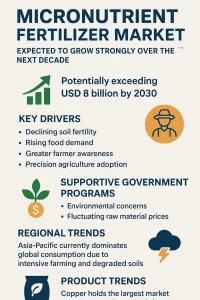The world food supply has stood squarely on the pillars of agriculture to supply the products required by the increasing population. Although such debates might be permissibly holistic with a primary emphasis on the main nutrients such as nitrogen, phosphorus, and potassium, plant science has always known the value of the micronutrients. Only small amounts of micronutrients can be necessary in the application, yet micronutrients (iron, zinc, manganese, and copper) are undoubtedly needed by various important processes in crops. A single lack of all these factors will lead to a reduction in growth, decreased yields, and overall low capacity of plant health.
Following the relevance of micronutrients in contemporary agriculture coupled with the evolving food needs, the micronutrient fertilizer sector has changed drastically to be the most expanding sector in the agricultural sector. Instead of a high volume category of product orientation, the present trends within the market are more of precision, performance and sustainability, which are driving new start-ups in the sector.
Learning about Micronutrients and their effect on Crop health.
Micronutrients refer to the trace elements that are important and absorbed in the soil, but they play a significant role in the healthy growth of plants. Boron, chlorine, copper, iron, manganese, molybdenum, nickel, and zinc are some of the important micronutrients. Such micronutrients have certain functions, such as zinc, which aides in metabolism; manganese, which activates photosynthetic enzymes; molybdenum, which helps in fixing nitrogen; and theboron which helps in protein synthesis and development of fruits. Besides the promotion of healthy plants, presence of micronutrients also aids crops to be resilient to drought, disease and other stressors.
One of the problems of micronutrients is the so-called hidden hunger, whereby a lack of a substrate limits profitability but does not show up visually. Diagnostic testing of soil and tissue simultaneously is needed to provide a reliable diagnostic of micronutrient deficiency. According to Liebig Law of the Minimum, indefinitely limited crop productivity is aggrieved by the substrate in the soil, i.e. a macronutrient will not substitute a lack of a single micronutrient.
Find our Handbook
Factors that Influence Availability of Micronutrients.
Micronutrient uptake is affected by the pH of the soil, organic matter, soil texture, soil moisture and temperature. Usually, the acid soils possess greater accessibility of the micronutrients compared to the alkaline soils and the poor access to nutrients is caused by sandy soils, low organic matters, cold and wet environments. The natural variation of soils between fields is a gift which makes soil testing and application very useful. To some extent, companies developing fertilizer/soil-testing combinations will possess some competitive advantages.
Fertilizer Market Trends of micronutrients.

The market of micronutrient fertilizers is highly projected to increase in the upcoming decade which might reach USD 8 billion by 2030. The major contributors are the decreasing soil fertility, increasing food market demand, increasing farmer consciousness, adoption of precision agriculture, and favorable governmental interventions. Although environmental issues and variability in raw material prices are problematic, they also drive the demand of high efficiency formulations that are eco friendly.
Farming and poor soils have led to extensive consumption in Asia-Pacific at the expense of the rest of the world. Copper has the highest market share, and boron and zinc will have the highest growth. The most prevalent mode of delivery is soil application whereas fertigation and foliar application is gaining popularity.
Fertilizers Manufacturing Handbook:- The related articles.
Micronutrient Fertilizer types.
- Sulphates are easily soluble in water and availed instantly to crops.
- Oxides are the slow releasing ones and can be applied to long term correction of soils.
- The high-quality ones are known as Chelates that are highly efficient and absorb better particularly in high pH soils.
- Oxysulphates combine both characteristics of oxides and sulphates by providing fast and slow release of nutrients.
Manufacturing Processes
Micronutrient fertilizers can be synthesized through chemical reactions, industrial byproducts, chelation or nano-formulation. Chelated products involve organic ligands like EDTA, citric acid to preserve nutrients in land and improve absorption. Controlled-release and nano-technology boosts the delivery of the nutrient and minimize environmental losses. One of the options is using byproducts that reduce the expenses with a high quality control to prevent contamination.
Modes of Application
Soil Application: – Still in common use as a source of early-season nutrition.
Foliar Application:- It provides nutrients to the crop using leaves to quickly correct deficiencies.
Fertigation:- Introduces nutrients by the use of irrigation systems, which are efficient and accurate.
Seed Treatment:- Lacquers the seeds with micronutrients to enhance early growth of the plants.
The products that can be used in various application methods will access a wider market.
Compliance and Quality Assurance.
Micronutrient fertilizers have controls that guarantee safety, environmental safety and accurate claims of nutrients. Manufacturers will have to register products, adhere to allowed limits of ingredients, label products, and adhere to the agencies like USDA, EPA and EU regulators. Quality testing involves testing of nutrient levels, pH, particle size and heavy metals. Credibility and expansion of markets are supported by third-party certifications.
Entrepreneurial Opportunity.
Micronutrient fertilizers are still in the future as innovation will keep on determining the future. New concepts are nano-fertilizers, controlled-release products, biodegradable formulations, organic micronutrients and micronutrient-biostimulant combinations. The differentiators that can be applied by the new businesses are product performance, delivery precision, robust quality control system as well as the built-in advisory services.
Conclusion
Find best business ideas for yourself our startup selector tools
About Niir Project Consultancy Services (NPCS)
Niir Project Consultancy Services (NPCS) prepares Market Survey cum Detailed Techno Economic Feasibility Reports. These reports include manufacturing processes, raw material requirements, plant layouts, and financial projections. NPCS assists entrepreneurs in analyzing the feasibility of starting or expanding industrial ventures.
Frequently Asked Questions
Q1. What are micronutrient fertilizers?
Micronutrient fertilizers are specialized products that supply trace elements such as zinc, iron, boron, and manganese—essential nutrients required in small quantities for healthy plant growth and optimum crop yields.
Q2. Why are micronutrients important in agriculture?
Micronutrients support critical functions such as photosynthesis, enzyme activation, nitrogen fixation, and disease resistance. Even a minor deficiency can limit plant growth and reduce yield, despite sufficient macronutrient supply.
Q3. What are the common signs of micronutrient deficiency in crops?
Typical symptoms include yellowing leaves, stunted growth, brown patches, poor fruiting, and distorted foliage. However, some deficiencies cause “hidden hunger,” where yield drops without obvious visual indicators.
Q4. Which factors affect micronutrient availability in soil?
Soil pH, texture, organic matter, moisture, temperature, and farming practices all influence micronutrient availability. High pH (alkaline) soils and sandy soils are particularly prone to micronutrient deficiencies.
Q5. What types of micronutrient fertilizers are available in the market?
The main types include sulphates (fast-releasing), oxides (slow-releasing), chelates (high-efficiency premium forms), and oxysulphates (hybrid forms with both immediate and residual effects).







